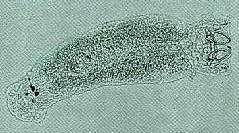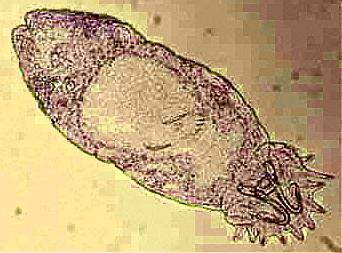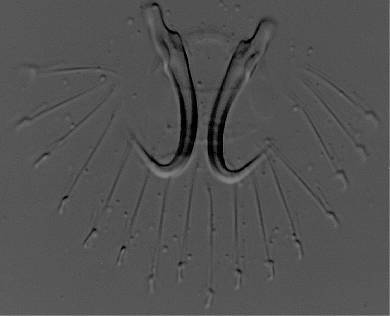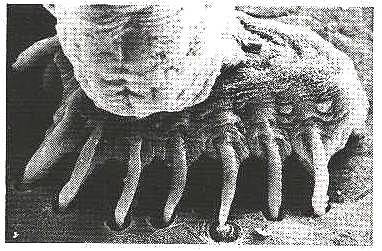ALL THINGS KOI AND H2O
YOU
FLUKEY LITTLE DEVIL YOU!
†Monogenetic Trematode
Flukes
DUNCAN GRIFFITHS
There are many parasites
that infect ornamental fish, but the ones that seems to instil fear in the
minds of koi keepers are flukes
Flukes belong to
Monogenetic Trematode parasitic flatworms genus. They exist in Many forms
and infect a many varieties of fishes.requiring only one host to complete
an entire life cycle, For our purpose's we will be discussing the main variety
gill fluke and skin or body fluke.
Before
we get into this subject lets clear a little misconception up,
The term gill fluke does not mean they are only to be found on the gill lamellae,
they are just at home on the main body of the koi
Gill Fluke.† Dactylogyrus†

Gill fluke are hermaphrodites
meaning they possess both female and male reproductive sex organs, thus a
pond devoid of all parasites (if such a thing can ever exist) that encounters
a solitary fluke can soon, if conditions prevail for that fluke to thrive,
be overrun with fluke.
There are about 100 subspecies the two main common species that are encountered
by the koi hobbyist are D. Vastator and D. Extensus, both require
a very slightly different temperature range but both are equally damaging
to fish.
The morphological difference between gill flukes and skin / body flukes is
that gill flukes are oviparous meaning egg laying protozoa's, and because
of the complexity of their life cycle are difficult to fully eradicate
Gill fluke are microscopic let me repeat that! *microscopic* and cannot
be seen with the naked eye, so if you are told otherwise, you now know.
However fortunately for us these critters can be seen quite well in great
detail at low magnification X40/X100 no more than this magnification is required
for identification purposes.
It will be noted that gill fluke has a typical worm like appearance and is
fastened to the epidermis by a foot like device, on the foot arranged around
the edge are very small sharp hooks called haptens, the fluke uses these to
move across the gill or body and anchor itself to the koi.At the other end
of the tube the anterior, are suckers that is used for the intake of food
and nutrients, these can also be seen as the gill fluke stretches and contracts
as the fluke ingests food matter, the fluke is capable of doubling in length
as this pulsating action takes place. This accompanied by two sets of paired
eyespots making four eyes spots in all at the sucker end of the fluke.
Flukes function in extreme
temperature ranges and can be quite adept even as low as 6 deg Celsius and
there is no know upper limit to their operating range of temperatures.
As mentioned before the gill fluke is an egg-laying parasite and treatment
is a little difficult as it is very much a case of which came first the chicken
or the egg
Newly emerged flukes, are fully free swimming smaller versions of the adult
and must attach to a host within around 24 hours or so or perish, this is
applicable to all temperature ranges once the fluke has hatched. Once attached
they very quickly start the reproduction cycle and disperse eggs into the
environment, but this is very temperature dependant, at low temperatures the
fluke will only release one or two eggs per hour, however as the pond temperature
rises to typical summer temperature ranges this will increase to over 20 eggs
per hour and beyond.
It must also be noted that in real cold climates both adults and eggs can
lay dormant for up to six months until the temperatures favour them.
Fluke eggs hatching rate is also temperature dependant at low temperatures
they will take months to hatch and can indeed lie in waiting for the temperature
to rise, or at summer temperatures will hatch in about 4 days, this makes
treatment extremely difficult in the case of Dactylogyrus, but not impossible,
so donít worry,
Skin fluke Gyrodactylus

Upon microscopic inspection of a skin fluke you will see a slightly fatter
version of the gill fluke with no eyespots evident and although the small
array of small hapten hooks can be seen you can also see a pair of particularly
nasty, very large pair of hooks formed into a classical H shape which Gyrodactylus
uses for anchorage on the body,

These primary hooks will be very evident upon inspection and will probable
be the very first thing you notice, thus it will always stand out in your
mind and be remembered,
Typically as you look to the middle section of the fluke you will notice the
unborn fully formed embryo and inside that yet another identified by those
large single pair of primary hooks,
The skin fluke is a little like those little wooden Russian dolls where on
taking the head section off there is yet a smaller one inside, so in one adult
skin fluke, there can often be seen several generations of fluke, one inside
the other.
Reproduction in skin fluke is also temperature dependant in much the same
way as gill fluke although skin fluke do seem more able at reproduction at
lower temperatures than gill fluke.-
It should also be noted that although both are parasites in the strict sense
of the word they do not feed on the life's blood of the host but merely attach
to the fish and feed on what passes by (dead cells etc). And provides no benefit
to the host.
So
why do fish die from fluke infestation?
As previously described the both types of fluke have a serious set of grippers (hooks)

And these are laced
with very virulent inoculate pathogenic bacteria, so as the fluke moves around
and secures itself on the host the hooks will puncture the surface of the
koi's skin or gill lamellae. This in most cases will cause an Aeromonas /
pseudomonas -infection, which can at best lead to a bacterial ulcer (hole
disease) and at worst bacterial gill disease (BGD), the latter of which is
as near to a death sentence for the koi as is possible, as BGD is very difficult
to cure and takes a lot of time and dedication to correct, its also a fact
that by the time the damage is usually notice the damage is already done and
beyond repair.
There is no upside to the damage inflicted by fluke.
If the life cycle of
Gyrodactylus and Dactylogyrus is full understood treatment becomes much or
effective and predictable, it must therefore be understood that save one treatment
a single treatment alone will not eradicate gill fluke, so we must employ
multiple sequenced treatments the time span of which will be determined by
the water temperature, since we are aiming to catch the emerging hatchling
fluke as well as the parent,
The parent is easily dealt with by many treatments, potassium permanganate,
formalin, chloramines T or Masoten, The latter of which is restricted in its
use being an organophosphate, but ultimately has been over used by the Japanese
breeders in their endeavour to over come fluke infestations and as such we
have seen a mutation of fluke that can survive Masoten exposure
Formalin whilst being effective treatment in many ways is a very efficient
consumer of valuable pond water oxygen, and therefore as the koi may have
compromised gill function would not be a first line choice of treatment.
(Antibiotics do not eliminate flukes or any other parasites) just I case you
were wondering, they only work against bacteria.
Potassium Permanganate
Potassium Permanganate is useful for gill and skin fluke control at
the rate of 1.5 gm per ton of water (220 imp gallons) or 1.5 ppm( parts per
million)
In order for this treatment to be effective against any fluke the typical
colour of an active dose of PP (bright pink) must remain pink for at least
4 hours,
The activity of Potassium Permanganate, is influenced by the organic load
of the water
Potassium Permanganate is an oxidizer and will oxides anything organic it
comes into contact with for our purpose this can and does work against us
as we treat, in some cases where a high organic load is present Potassium
Permanganate will spend itself on the organics dissolved in the water and
exhaust itself before an effective time period has elapsed to treat the parasite
I.E. the dirtier the higher the organic load, quicker the pink of the water
goes to a tea brown colour, thus the pp is spent and of no danger to anything.
If this occurs a second half dose of the original dose @0.75 gm per ton should
be administered and hopefully a longer duration to a total of 4/5 hours of
pink can be achieved to damage and kill the fluke.
Potassium Permanganate
at the dose described above, is only a dose of 1.5ppm, thatís 1,5 parts Potassium
Permanganate to 1 million parts water thatís how powerful Potassium Permanganate
is. A dose of 2 to 3 ppm can be tolerated by koi but you are now in the land
of, will it kill my koi or wont it?
The author does not recommend any other dose than the 1.5 gm per ton of water
and a further half dose if it turns a very definite brown colour before 4
hours have elapsed.
Further to this it is important that the original dose is very definitely
brown in colour, failure to observe this colour protocol will result in an
overdose and very dead koi!!!
Two more observations, always know you pond volume before hand and gm weigh
the dose precisely, there is no other way to administer this chemical
If you do not observe volume and weight dose protocol exactly the best that
will occur is, at best you will under dose and achieve nothing and at worst
overdose and kill koi, so be warned!A handy tip when using Potassium Permanganate
is to keep on hand some pond dechlorinator or sodium thiosulfate, which is
to be found in most commercial dechlors.
If for some reason you take your eye off the ball and over dose and the koi
come skyward gasping, it should be noted that if you treat the whole contents
of the pond with a standard dose of dechlor it will neutralize Potassium Permanganate
in seconds and the whole mess will turn brown rendering the occupants safe
from the effects of the Potassium Permanganate oxidisation process.
When treating gill fluke it is important to catch the emerging hatching fluke, and this can best be achieved in temperatures above 17/18 deg and a sequential doses of the above 1.5 gm per ton, spaced five days apart for 3 treatments maintaining the active pink colour for a minimum time period of 4 hours and no more than 7 hours at one time.
Chloramines T is another
good choice for skin and gill fluke and in many ways as long as the ph value
of the water is 7.5 or above is quite forgiving on the koi but not the fluke
Dose at 2 gm per 100 imperial gallons on days one, two and three, leave for
seven days and do a one off dose at 2 gm per 100 imp gallons,
There is an additional benefit of the use of Chloramine T in so much a it
will reduce the bacterial count both in the pond water and also at 2 gm per
100 on the fish
Once again if your fish show any sign of stress to a C/T treatment dechlor
will neutralize the effects of Chloramine T.
supaverm is an oral sheep drench for intestinal worms in the afore
mentioned sheep.And has been developed for use in koi
This is the ultimate big stick against both skin and gill fluke requiring
only a one off dose as it destroys the eggs as well.
However this substance is restricted and is hard to locate, plus in the UK
it is illegal to use a wormer for any other beast other than that for which
it was originally intended for use on, having said all that it is available
from various sources usually at exorbitant prices, but as said already it
is the last word in fluke treatments
Dose at 1 ml/cc per
100 imperial gallons. As a one off treatment administer over three to four
hours spreading around the pond, after 48 hours do a couple of 15% partial
water changes over a couple of days
Be warned!
Supaverm may stress and burn the fish in some cases, it will burn the
intestine of the fish and as a result the fish may redden and show typical
stress in this case do a partial water change, the koi usually bounce right
back with renewed vigour
If however you are counting multiple fluke on each and every mucus scrape
under microscopic examination this should set alarm bells ringing even if
the koi may behaving normally for your pond situation, that something is out
of the koi's normal control. (and only you will know this)†In
time or when pond parameters or pond temperatures take a turn for the worst
the koi could and probably will come under a very real threat from flukes.
†